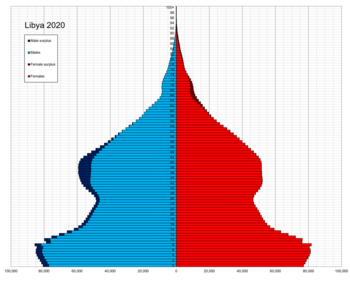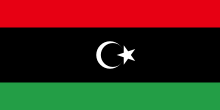
Back ليبيون Arabic Liviyalılar Azerbaijani Население на Либия Bulgarian Libyens demografi Danish Demografía de Libia Spanish Démographie de la Libye French ლიბიელები Georgian 리비아의 인구 Korean Libijos demografija Lithuanian Демографија на Либија Macedonian
| Demographics of Libya | |
|---|---|
 Population pyramid of Libya in 2020 | |
| Population | 7,137,931 (2022 est.) |
| Growth rate | 1.65% (2022 est.) |
| Birth rate | 21.56 births/1,000 population |
| Death rate | 3.45 deaths/1,000 population |
| Life expectancy | 73.29 years |
| • male | 70.27 years |
| • female | 76.11 years |
| Fertility rate | 3.09 children |
| Infant mortality rate | 5.22 deaths/1,000 live births |
| Net migration rate | 1.61 migrant(s)/1,000 population |
| Sex ratio | |
| Total | 1.04 male(s)/female (2022 est.) |
| At birth | 1.05 male(s)/female |
| Nationality | |
| Nationality | Libyans |
| Major ethnic | Arabs (92%)[1] |
| Minor ethnic | Berbers (5%) Others (3%)[1] |
| Language | |
| Official | Arabic |
ليبيون (Libiūn) | |
|---|---|
 | |
| Total population | |
| c. 8 million | |
| Regions with significant populations | |
7,137,931 (2022 est.)[2] | |
| 300,000 (2018)[3] | |
| 250,900 (2018)[citation needed] | |
| 200,000 (2016)[4] | |
| 55,000 (2015)[citation needed] | |
| 54,500 (2022)[citation needed] | |
| 50,600 (2019)[5] | |
| 25,000[citation needed] | |
| 21,677 (2022)[6] | |
| 15,000 (2019)[citation needed] | |
| 14,000[7] | |
| 13,827[7] | |
| 13,545[8] | |
| 11,979 (2000)[9] | |
| 11,000 (2021)[citation needed] | |
| 5,622 (2017) | |
| 1,112 (2024)[10] | |
| 1,000 (2019)[citation needed] | |
| Languages | |
| Majority: Arabic (Libyan Arabic) Minority: Berber (Awjila, Nafusi, Tamasheq), Teda Foreign: Italian, Turkish, English, Greek | |
| Religion | |
| Majority: Sunni Islam Minority: Ibadi Islam and Christianity | |
Demographics of Libya is the demography of Libya, specifically covering population density, ethnicity, education level, health of the populace, economic status, and religious affiliations, as well as other aspects of the Libyan population. The Libyan population resides in the country of Libya, a territory located on the Mediterranean coast of North Africa, to the west of and adjacent to Egypt. Libyans live in Tripoli. It is the capital of the country and first in terms of urban population, along with Benghazi, Libya's second largest city.
- ^ a b c "Population of Libya". Fanack.com. Retrieved 18 September 2022.
- ^ Cite error: The named reference
.cia.govwas invoked but never defined (see the help page). - ^ محمود بن رمضان: عدد الليبيين المقيمين في تونس يتراوح بين 300 و350 ألف شخص. tuniscope.com (in Arabic). 6 March 2018. Retrieved 6 July 2024.
- ^ "Libyans in Egypt losing hope of returning home". Retrieved 7 October 2018.
- ^ "Jews, by Country of Origin and Age" (PDF). Retrieved 13 March 2021.
- ^ "Uyruklarına göre Türkiye'de Yabancı Nüfus (2022 yılı)". November 2023.
- ^ a b "Migration Facts Libya April 2013" (PDF). EU Migration Policy Centre. Retrieved 26 December 2016.
- ^ "Immigrant status and period of immigration by place of birth and citizenship: Canada, provinces and territories and census metropolitan areas with parts". Statistics Canada. Statistics Canada Statistique Canada. 7 May 2021. Retrieved 3 January 2023.
- ^ "Archived copy". Archived from the original on 23 July 2017. Retrieved 18 February 2018.
{{cite web}}: CS1 maint: archived copy as title (link) - ^ Immigrants in Brazil (2024, in Portuguese)